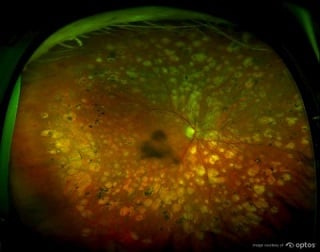In adult patients ages 20 to 74, diabetic retinopathy is the leading cause of new blindness cases every year. As a highly specific negative vascular affectation, diabetic retinopathy is associated with both type 1 and type 2 diabetes, becoming more prevalent the longer the patient has had the disease. As a health professional on the front lines of preventing blindness, it is critical to provide your patients with education about diabetic retinopathy screening.
 You should perform a comprehensive eye exam, including an optomap as a first screening for your diabetic patients. From this exam you will be able to pinpoint possible problem areas and development of any diseases if they exist. Discuss your findings with your patient and impress upon them the importance of serious diabetes management to prevent or delay diabetic retinopathy or macular edema.
You should perform a comprehensive eye exam, including an optomap as a first screening for your diabetic patients. From this exam you will be able to pinpoint possible problem areas and development of any diseases if they exist. Discuss your findings with your patient and impress upon them the importance of serious diabetes management to prevent or delay diabetic retinopathy or macular edema.
Since blindness can be prevented or prolonged through early detection, utilizing ultra-widefield retinal imaging devices for treatment of your diabetic patients, can help. Depending on the results from the first screening, develop a follow-up screening program and explain to your patients why these regular screenings are critical to maintain their vision. Be sure they understand that although they may not experience vision loss or other symptoms, careful monitoring is required because oftentimes the damage is too great to correct once symptoms begin to appear.
Patient education is one of the best ways to encourage people to maintain their diabetic retinopathy screening exams. If they have a clear understanding that careful maintenance of their disease, early detection and treatment are all necessary to maintain their vision, they will take their condition more seriously and actively participate in their care.
Ultra-widefield retinal imaging devices not only allow you to diagnose conditions sooner, they also aid your practice because they are faster and cause less discomfort than traditional retinal screenings. Contact Optos to learn how our ultra-widefield retinal imaging devices can help your practice.
Image Source: optomap